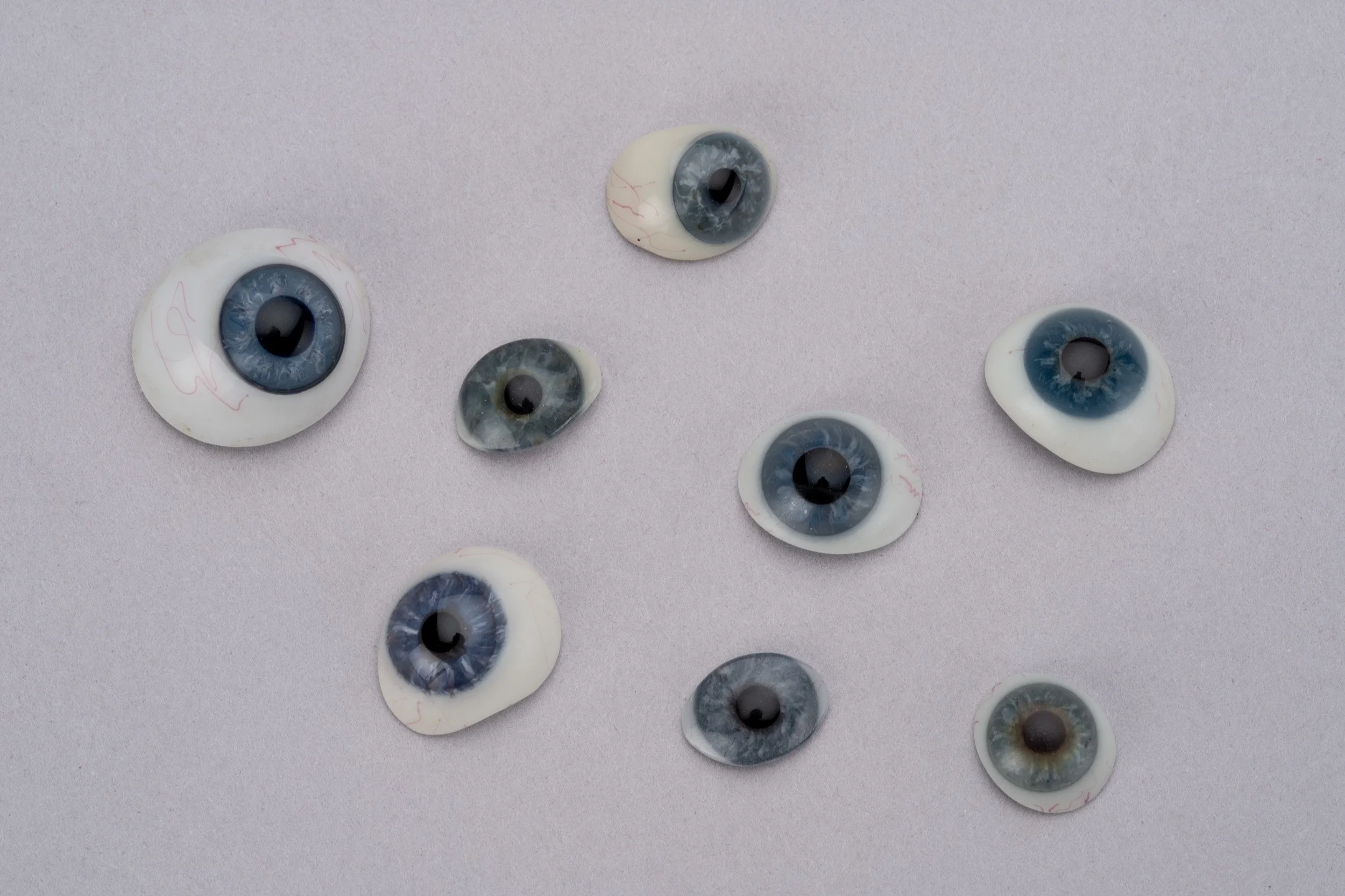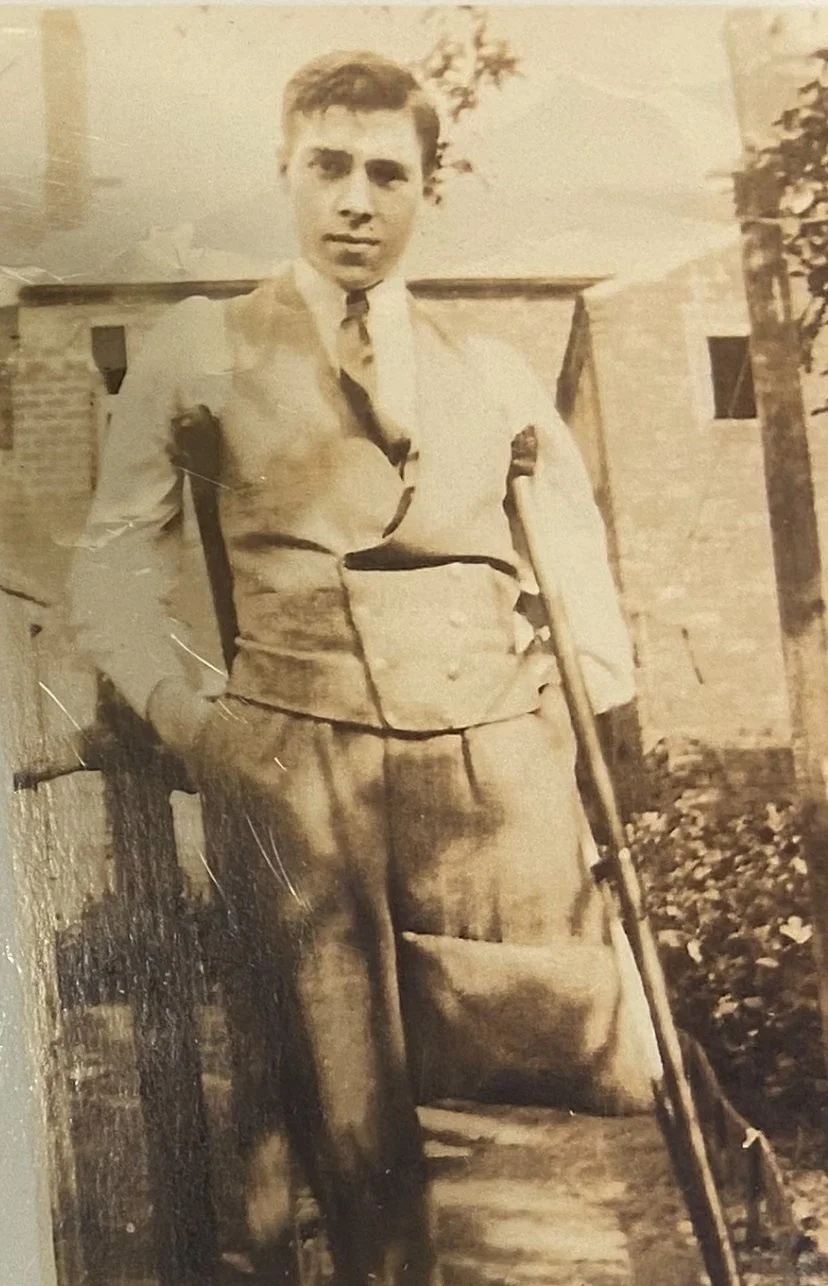To use or not to use?
Explore two peoples’ very different experiences with prosthesis.
Horace Reginald Greaves (left) and Gladys May Hewston (right)
Despite both having prosthetics designed to aid their daily lives, Gladys Hewston and Horace Greaves’ experiences with prosthetics could not be more different. While Gladys went to great lengths to continue using her glass eyes even throughout her later life, Horace never wore his metal prosthetic leg. Through information supplied by the families of Gladys and Horace upon donating the objects to the collection, we can explore the relationships both people had with prosthetics and how much of an impact they had on their daily life.
Photograph of Gladys Hewston as a small child
For Gladys, the prosthetic eyes were a constant throughout her life. During birth, Gladys Hewitt’s right eye was damaged with forceps and was later removed completely at the Birmingham and Midland free Hospital for Children. During Gladys’ younger years, her mother returned to work to afford the best hand-painted glass eyes for the girl, matching the blue of the glass eye to her left eye. A close look reveals the extreme detail in the tiny red veins and precise blue colouring in the eyes.
Gladys’ glass eyes
Close up of glass eye
During childhood she was treated with a sense of protectiveness with her family’s worries that she would not marry or gain employment; which led to the decision for her to learn the piano. Despite her family's worries about her getting on in life, she lived a happily ordinary life, gaining employment and getting married.
Photograph of Gladys Hewston wearing her glass eye
As Gladys grew older and the eye socket began to heal, she would bathe the eye in creams and acids to prevent full healing to continue using the glass eyes. As her sister recalled, she never complained about the disability despite the pain which it caused. The extremes Gladys went to, to continue using her prosthetics, demonstrate how much they improved her quality of life and sense of identity throughout her adult life. The social and psychological benefits of prosthetic eyes can greatly impact a person's quality of life and confidence.
However, while Gladys’ experiences with glass eyes became a daily part of her life, Horace Greaves had a very different experience when it came to his medical prosthetics.
Horace Greaves (left) attending a friend’s wedding
Upon a first look at the prosthetic leg, one thing that strikes you is the cleanliness and pristine appearance. The metal is not scuffed, the leather straps not worn or discoloured and the shoe looks like it hasn't walked a mile (despite the fact that Horace walked over a mile every day of his working life to work). So why does this leg look so unused? Because that's just what it was, unused!
Horace’s Desoutter prosthetic leg
Horace’s leg was amputated when he was between 7-10 years old after a bruise received playing football went through to the bone. Horace went on to work as a tool maker throughout his life and got married in 1941. During the engagement to his wife, he would walk for over an hour to see her every day. Throughout WWII, Horace also took part in the fire watch, which involved keeping a lookout in urban areas for signs of fire and alerting fire brigades if fire breakouts occurred. As his children remember: “the only thing dad found impossible to do was push a wheelbarrow (...) he could do everything else”.
Photograph of Horace in late teens or early twenties
Horace’s Desoutter prosthetic leg was issued to him when he was about 31 years old, and so for the majority of his life he had lived without the limb. As he was quite well known for having one leg only, he was teased when this new leg was acquired as his distinctive appearance was gone. It can also be difficult for someone to adjust to having a prosthetic leg due to the discomfort of rubbing, sweating and general fatigue of using them. For Horace, who had lived his entire adult life with only one leg, adapting to the weight and balance of a second limb would also have been a challenge. Therefore, for Horace, the prosthetic leg was never really worn.
Horace’s prosthetic leg
Despite both living with prosthetics in the mid-twentieth century, Gladys’ and Horace’s experiences with prosthetics impacted their lives in very different ways. Exploring individual stories and experiences is key to understanding the experiences of disabled people rather than seeing their lives purely in terms of medical advancements.
Despite the technological and medical progress of prosthetic limbs in the twentieth century using lightweight metal as opposed to the previous century’s use of wood, personal choice ultimately dictates whether an individual decides to use available technology. Whilst many people do choose to use prosthetic legs for aesthetic or functional reasons, it is important to acknowledge that this is not the case for every amputee. Highlighting the experiences of Horace Greaves enables an understanding of the limitations of prosthetics and how disabled people do not share one universal experience.
For some people, using prosthetics is an important way of reclaiming their sense of identity and confidence. Gladys Hewston went out of her way to keep her glass eye, even through discomfort, yet Horace Greaves never properly used his prosthetic leg. Every person's journey is individual and medical intervention is not a one size fits all solution – in some ways quite literally!
Understanding the daily lives of disabled people is very important in enabling a full understanding of each person - rather than just a disability. Both Gladys and Horace led full lives, despite their differing uses of prosthetics. Their identities as spouse, parent, employee, friend, are so central in remembering the individuals displayed in museums.









